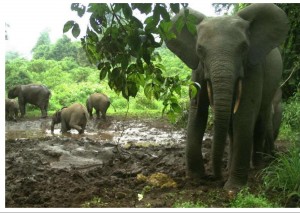Isaac Djoko
PhD. Student
Contact Information
Department of Biology
Concordia University (Loyola Campus)
7141 Sherbrooke St. W. H4B 1R6
Montreal, QC, Canada
Office: SP301.14
Lab: SP434
(514) 848-2424 (ext. 4021)
Education
2017 – 2022: PhD in Ecology at Concordia University, Montreal, Canada
2010-2013: MSc Management of Natural Resources, University of Dschang, Cameroon
2000-2005: BSc. Wildlife and Forestry, University of Dschang, Cameroon
My Project
Interactions Between People and Protected Areas: The Case of Campo-Ma’an National Park, Southern Cameroon
Background
With the creation of protected areas by the colonial administrations, the people who once lived in harmony with their environment have lost ownership, as well as access or decision rights on natural resources including wildlife. The frustrations arising therefrom, in addition to losses inflicted upon them because of the damage caused to crops by wildlife, created in them feelings of retaliation, leading to poaching and rejection of wildlife policies. Due to the growing encroachment and fragmentation of wildlife habitat by humans near protected areas, the upsurge of poaching activities, encounters between humans and large mammals such as elephants or great apes, could intensify and have a dramatic impact on their survival in the long term. Hence, the conservation of those animals become a concern as it is known for example that elephants are keystones species that migrate using the same corridors over years often to get foods and water. However, in Campo-Ma’an region, it is reported that the damages to crops are the most common forms of Human-Wildlife Conflicts (HWC) in which elephants, great apes and rodents would inflict huge economic losses to the local residents.
Field Work
This research will take place at the Campo-Ma’an Technical Operational Unit that encompasses the Campo-Ma’an National Park (CMNP) and its surroundings, situated in the Southern region of Cameroon. Many villages report crop raiding by animals from the park, especially elephants whose population has been estimated to about 596 (range: 368 – 964) individuals but their home range, migratory corridors and impacts on the environment remain unknown.

Objectives
Above its contribution to the implementation of the management plan of the Campo-Ma’an National Park, this research aim to contribute to a better knowledge of the dynamics of HWC with emphasis on elephant in a perspective of integrated management of the area that maintain biodiversity while providing better coexisting conditions to different stakeholders in the Campo-Ma’an Technical Operational Unit
Specifically, the study will:
- Assess the socio-economic impact of the interactions around CMNP;
- Study the relationship between different stakeholders of the conservation;
- Assess people’s attitudes and perceptions towards wildlife, the park and the wildlife legislation;
- Study some ecological aspects of the elephants; and finally, based on the findings;
- Provide mitigation strategies, through development and test of some biological deterrents methods, for a successful coexistence between people and wildlife in the Campo-Ma’an area, with realistic solutions that can be applied elsewhere.
Publications
- Temgoua, L. F., Momo Solefack, M. C., Tchiofo Lontsi, R., & Djoko, I. B. (2018). Teneur en eau du sol et diversité floristique sous plantations d’Eucalyptus saligna Smith (Myrtaceae) à l’Ouest Cameroun [ Soil water content and floristic diversity under Eucalyptus saligna Smith (Myrtaceae) plantation in Western Region of Cameroon. International Journal of Innovation and Applied Studies, 24(1), 368–378. https://1library.net/document/zlen6mrq-content-floristic-diversity-eucalyptus-myrtaceae-plantation-western-cameroon.html
- Djoko* I. B., R.B. Weladji & P. Paré (2018). Interactions between people and protected areas: the case of Campo – Ma’an National Park, Southern Cameroon. Société Québécoise d’Étude Biologique du Comportement. 16-18 November, 2018, Trois- Rivières, Québec, Canada (poster).
- Djoko I. B. 2019. Comprendre et résoudre les conflits Humains- Éléphants à Campo-Ma’an – https://lebeagle.qcbs.ca/blog/comprendre-et-resoudre-les-conflits-humains/
- Djoko* I. B., R.B. Weladji & P. Paré (2020). Use of African honeybees (Apis mellifera adansonii, Latreille, 1804) to mitigate crop raiding by elephants: an experimental approach. Société Québécoise pour l’Étude Biologique du Comportement. December 10, 2020. (oral presentation online) https://www.youtube.com/watch?v=hN9rik-VcTQ&t=6s..
- Djoko* I. B., R.B. Weladji & P. Paré (2020). Use of African honeybees (Apis mellifera adansonii, Latreille, 1804) to mitigate crop raiding by elephants: an experimental approach. Quebec Centre for Biodiversity Science. (Oral presentation online) https://www.youtube.com/watch?v=hN9rik-VcTQ&t=6s.
- Djoko* I. B., R.B. Weladji & P. Paré (2020). Interactions between people and protected areas: the case of Campo – Ma’an National Park, Southern Cameroon. Research seminar. 02 November, 2020, Montréal, Québec, Canada (Oral presentation online).
- Djoko I. B. 2020. Beekeeping for the conservation of elephants and improving the living conditions of rural populations- https://lebeagle.qcbs.ca/blog/beekeeping-for-the-conservation-of-elephants-and/
- Djoko I. B., A. Granados, R.B. Weladji & P. Paré (2021). First direct evidence in two decades of African Leopard (Panthera pardus pardus) in Campo-Ma’an National Park, southern Cameroon. CAT News 72, 04-05.
- Djoko I.B., R.B. Weladji, A. Granados, P. Paré & G. Body (2022). Fruit availability influences forest elephant habitat use in a human dominated landscape, Campo-Ma’an, southern Cameroon. Canadian Black Scientists Network. BE-STEMM National Research Conference 2022 (oral presentation online).
- Djoko I.B., R.B. Weladji & P. Paré (2022). Diurnality in the defensive behaviour of African honeybees (Apis mellifera adansonii) and implication for their potential efficacy for beehive fences in Campo-Ma’an, Cameroon. Oryx, 1-7. https://doi.org/10.1017/S0030605321001721.
- Djoko I.B., R.B. Weladji, A. Granados, P. Paré & G. Body (2022). Fruit availability influences forest elephant habitat use in a human dominated landscape, Campo-Ma’an, southern Cameroon. Tropical Conservation Science. https://doi.org/10.1177%2F19400829221117053.
- Djoko I.B., R.B. Weladji & P. Paré (2022). Combining local ecological knowledge and field investigations to assess diet composition and feeding habit of forest elephants in Campo-Ma’an National Park, southern Cameroon. International Journal of Biodiversity and Conservation, Vol. 14(3), 103-114, https://doi.org:10.5897/IJBC2022.1549.